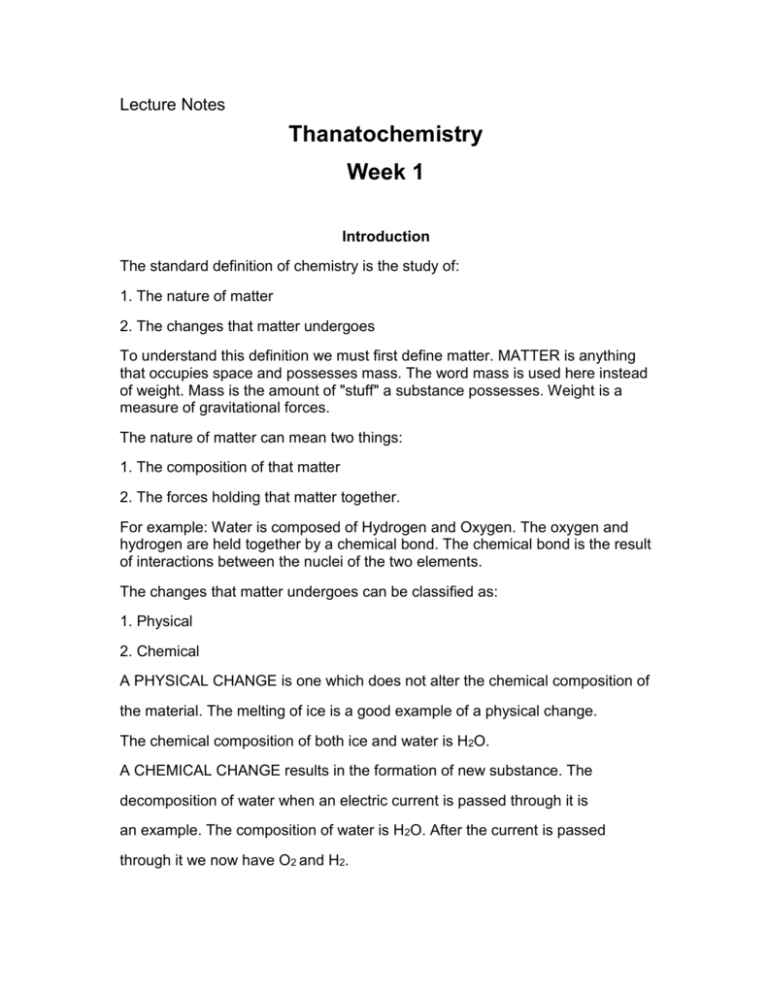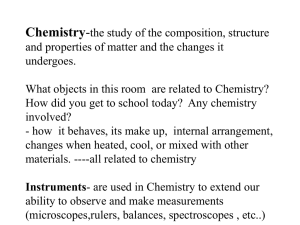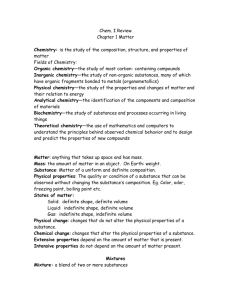Lecture Notes
advertisement

Lecture Notes Thanatochemistry Week 1 Introduction The standard definition of chemistry is the study of: 1. The nature of matter 2. The changes that matter undergoes To understand this definition we must first define matter. MATTER is anything that occupies space and possesses mass. The word mass is used here instead of weight. Mass is the amount of "stuff" a substance possesses. Weight is a measure of gravitational forces. The nature of matter can mean two things: 1. The composition of that matter 2. The forces holding that matter together. For example: Water is composed of Hydrogen and Oxygen. The oxygen and hydrogen are held together by a chemical bond. The chemical bond is the result of interactions between the nuclei of the two elements. The changes that matter undergoes can be classified as: 1. Physical 2. Chemical A PHYSICAL CHANGE is one which does not alter the chemical composition of the material. The melting of ice is a good example of a physical change. The chemical composition of both ice and water is H2O. A CHEMICAL CHANGE results in the formation of new substance. The decomposition of water when an electric current is passed through it is an example. The composition of water is H2O. After the current is passed through it we now have O2 and H2. Accompanying physical and chemical changes are energy changes, which are some of the most important types of changes that matter undergoes. ENERGY is defined as the ability to do work and can be divided into: 1. POTENTIAL ENERGY 2. KINETIC ENERGY POTENTIAL ENERGY is energy which is inherent in a system. Batteries have potential energy. They have energy in them which has the "potential" to make the toy run. Chemical substances have chemical energy which is a form of potential energy. This energy is released during chemical reactions. KINETIC ENERGY is energy of motion. The energy released as a ball rolls across the floor is a form of kinetic energy. DIVISIONS OF CHEMISTRY The three major divisions of chemistry are: 1. Organic 2. Inorganic 3. Biochemistry We will also be studying embalming chemistry. Let us first start by defining ORGANIC CHEMISTRY. Originally organic chemistry was the study of compounds that could be produced only by living organisms. This definition was found to be in error in 1828 when Wohler synthesized urea, a compound normally produced by animals. He did this by heating a nonliving compound called ammonium cyanate. Heat + NH4+NCOAmmonium Urea Cyanate Since the time of Wohler, ORGANIC CHEMISTRY has been defined as the study of certain carbon containing compounds. BIOCHEMISTRY is the term used for the study of substances produced by living organisms. INORGANIC CHEMISTRY is the study of minerals and other inanimate materials commonly found in the earth. The study of Inorganic chemistry includes carbon monoxide, carbon dioxide, the carbonates and the bicarbonates even though they contain carbon. EMBALMING CHEMISTRY is the study of those types of matter and changes in matter related to the disinfection and preservation of a human remains. CHEMICAL MEASUREMENTS Chemists are involved in making measurements of physical quantities, of which we will consider four: length, volume, mass, and heat. Each quantity has a standard unit in the metric system and divisions and multiples of the standard that are based on graduations of ten. Table of prefixes used in measurements deci 1/10 = 0.1 centi 1/100 =0.01 milli 1/1000=0.001 micro 1/1,000,000 =0.000001 deca 10 hecto 100 kilo 1000 mega 1,000,000 LENGTH The standard unit of length is the meter(m). 1 meter(m) = 10 decimeter(dm) = 100centimeters(cm) = 1000 millimeters (mm). 1000meters(m) = 1 kilometers(km). (The letters in parenthesis represent the appropriate abbreviations for that measurement.) VOLUME The standard unit of volume is the liter(l). One other important volume unit is the milliliter(ml). There are l000 ml in one liter. The milliliter is sometimes called a cubic centimeter (cc). A cube having a length, width, and height each equal to one centimeter has a volume of one cubic centimeter. Since one milliliter of water will fill this cube at 4o centigrade, it is consistent to say that one milliliter equals one cubic centimeter. 1ml = 1cc. MASS The standard unit of mass is the kilogram (kg). Smaller units of mass are the gram (g) and the milligram (mg). 1kg = 1000g and 1g = 1000mg. HEAT The standard unit of measurement for heat is the calorie (cal). The calorie is defined as the quantity of heat necessary to raise the temperature on one gram of water 1o centigrade at 15o centigrade. In metabolic processes the calorie is often too small a unit, the kilocalorie(Kcal) is used. The kilocalorie is equal to 1000 calories. The kilocalorie is also symbolized as Cal. 1Kcal = 1Cal = 1000cal. CONVERTING BETWEEN MEASUREMENTS Sometimes in the chemistry lab we are given measurements that need to be converted to other measurements before we can proceed with our experiments. The stairs below are an easy way to do this. First example: I have 10.0 liters of a liquid, and I need to determine how many milliliters I have. Liter is three steps to the right of the Milli. Therefore, I move my decimal point three steps to the right. My 10.0 liters becomes 10,000 ml. Second example: I have 1000.0 ml, and I need to determine how many kiloliters I have. Milli is six steps to the left of kilo. Therefore I move my decimal point six steps to the left. My 1000.0 ml becomes .001 kl. WEEK 1 PHYSICAL AND CHEMICAL CHANGES PHYSICAL PROPERTIES PHYSICAL PROPERTIES are characteristics that can be observed without altering the chemical composition of a substance. Typical physical properties are: 1. Odor 2. Color 3. Taste These all describe what a substance IS. For example: A lemon is yellow and is sour. Another common physical property is the STATE in which a type of matter exists at a given temperature and pressure. We are familiar with the three states of water: ice, liquid water and water vapor or steam. In each state water’s chemical composition is the same, but the physical characteristics are different. Some other examples of physical properties include a substance’s MELTING POINT and BOILING POINT, its SOLUBILITY in other substances, and its DENSITY and SPECIFIC GRAVITY. The melting point of a substance is that temperature at a given pressure at which a substance changes from the solid state to the liquid state. For pure water themelting point is 32oF or 0oC. The Freezing point of a substance is the same as the melting point, since the process of freezing is the opposite of melting. The boiling point is defined as that temperature at which a substance changes from the liquid state to the gaseous state. This property is also pressure dependent. For pure water at a pressure of one atmosphere the boiling point is 212oF or 100oC. If the atmospheric pressure is decreased such as on a mountain top, water will boil at a lower temperature. All substances have their own characteristic melting and boiling points as measurable physical properties which can be used to identify them. Another physical property of a substance is its Solubility. We can measure the amount of salt that will dissolve in a given amount of water. If we do this we are measuring the physical property of solubility. The salt and water do not chemically react. The salt is simply dissolved in the water. Density is another quantitative physical property. Density expresses the relationship between mass and volume and can be mathematically defined as: D=M/V. The normal density units for solids and liquids are grams/milliliter and the units for gases are usually grams/liter. In the lab densities are determined by a procedure known as displacement of water. The technique can not be used with solids that dissolve in water. All substances have a specific density by which they can be identified. Pure water has a density of 1g/ml because one gram of purewater occupies a volume of 1ml at 4oC. Examples: If 10 grams of a substance occupies a volume of 2ml, what is the density of the substance? D= 10g/2ml=5g/ml A test tube has 10ml of water in it. After placing 30g of our substance in the test tube, the new water level reads 20ml. What is the density? We first need to determine the volume that the substance occupies. Volume = 20ml - 10ml = 10ml So Density = 30g/10ml = 3g/ml A physical property that is closely related to density is Specific gravity. For liquids and solids, this property is the ratio of the mass of the substance to the mass of an equal volume of water at the same temperature. Specific Gravity = mass of the solid or liquid mass of an equal volume of water Specific gravity is a ratio and has no units. CHEMICAL PROPERTIES CHEMICAL PROPERTIES are characteristics which can be observed when the substance is interacting with other forms of matter. Chemical properties tend to define what a substance does. The interaction results in an alteration of the chemical composition of the substance. When iron is exposed to the air it chemically reacts with the oxygen to form iron oxide (rust). This is a chemical change because we now have different chemical substances than those which we started with. Not all substances simply dissolve in water. Some substances such as sodium will chemically react with the water. 2Na + 2H2O 2NaOH + H2 Notice that we end up with completely different substances than those with which we started. PHYSICAL AND CHEMICAL CHANGES A PHYSICAL or a CHEMICAL CHANGE is a process that manifests either a physical or chemical property. Common physical changes are changes in state. For example, when ice melts we can observe water’s physical properties. Another common physical change is dissolving one substance in another such as salt in water. Evaporation of the water from the salt demonstrates that dissolving is a physical change, because the original solid salt is still present after the evaporation of the water. Chemical changes form new substances with their own chemical and physical properties. Some examples of chemical changes are rusting of iron, burning of paper, and souring of milk. Chemical changes of importance to the embalmer are cremation of remains, decomposition, and embalming of remains. When iron rusts, it unites with oxygen in the air, forming iron oxide. An OXIDE is a substance containing two elements, one of which is oxygen. Whenever matter is burned in the presence of oxygen oxides are produced. Another name for this chemical change is COMBUSTION. This also occurs when remains are cremated. The breakdown of biochemical compounds into smaller, units is initiated by a process called HYDROLYSIS. This process involves water reacting with the substance and is also a chemical change. The embalming process attempts to disinfect and preserve human remains, thereby slowing the rate of this chemical change. Lecture Notes






